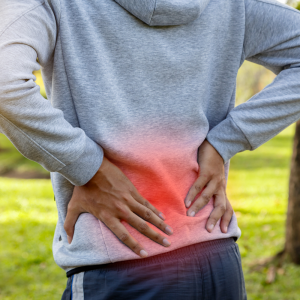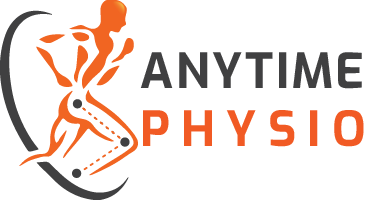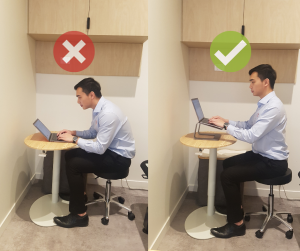How to Treat Lower Back Pain: A Physiotherapist’s Comprehensive Guide
Lower back pain is a common complaint that physiotherapists see in their practices. It can be debilitating and make individuals feel low on energy, so it’s important to know how to manage the condition as quickly as possible. In this blog post, we will discuss low back pain causes and symptoms, treatment options, self-management strategies, exercises for low back pain relief and more!

What causes low back pain?
Low back pain can be caused by an injury, such as a muscle strain or sprain from sudden or repetitive movements. Some low back pain is the result of overuse, such as prolonged sitting or standing. Sometimes, low back pain can be caused by a lack of low back strength and stability in everyday movements.
Lower back injuries are common among athletes because they often involve sudden twisting motions that may put too much stress on one side of your lower spine (especially if you have an imbalance in your lower back and pelvis). Sometimes this leads to herniated discs or other spinal damage. Other causes include being overweight, which puts more pressure on your low back, having poor posture while sitting for long periods of time, moving incorrectly during pregnancy, especially when lifting heavy objects, or wearing high heels all day every day.
The first step in treating low back pain starts by identifying what may be causing it. Most low back injuries are due to overuse or repeat injury (such as from a previous fall), but some people might also have an underlying condition that needs treatment such as conditions like arthritis, osteoporosis, or lupus, spinal disorders including herniated discs or degenerative disc disease. It is also important to exclude other causes of low back pain such as infections or tumours around the spine.
Here are the most common causes of low back pain that we see in our physiotherapy practice:
- Lumbar disc bulge
- Lumbar disc herniation
- Sciatica
- Lumbar facet joint sprain
- Sacroiliac joint pain
In this blog post, we will explore each of these conditions, discussing common symptoms, treatment options, self-management strategies and our recommended exercises for relief from your low back pain.
Lumbar disc bulge
A lumbar disc bulge is a low-grade spinal condition. It occurs when there is a small protrusion at the outer edge of one or more intervertebral discs in the lower back. The exact cause of this condition isn’t known but it may be related to age, lifestyle factors such as work and sport, as well as genetic factors. Disc bulges may occur during a sudden loading event, but may also be the result of repetitive overuse. Many people cannot remember the exact moment when their back pain started.
A disc bulge may produce mild-to-moderate central lower back pain. Larger disc bulges may also compress the nerves in the lumbar spine, resulting in sciatica.
Common symptoms of lumbar disc bulges
- Central lower back pain
- “Band-like” radiation to both sides of the low back
- Pain with bending forwards
- Pain with lifting
- Pain with twisting movements
- Pain with sneezing and/or coughing
Treatment options for lumbar disc bulges
If you suspect that you have lumbar disc bulge injury, then we recommend seeking physiotherapy treatment first before undertaking muscle strengthening exercises because you need to have a good functional range of motion in the low back before you start strengthening it.
Possible physiotherapy treatments may include:
- Spinal mobilisation and manipulation
- Soft tissue massage
- Dry needling and acupuncture
- Exercises and stretches
- Clinical Reformer pilates
The good news for people with disc bulges is that, in the majority of cases, the pain associated with a mild-to-moderate disc bulge is easily treatable with physiotherapy, rest and gradual return to sport and work.
Exercises for lumbar disc bulges
- Knee to chest stretch
- Knee rocking stretch
- Lumbar spine twist
- Trigger point release of the lower back and gluteal muscles
- Glute bridges
- Transversus abdominus activation drills
There are many other great exercises for treating lower back pain and we recommend that you see a physiotherapist for more specific advice about your back pain.
Lumbar disc herniation
A lumbar disc herniation is another common cause of low back pain. It occurs when there is a larger protrusion of one or more of the lumbar discs. Often, lumbar disc herniations cause more severe pain that disc bulges. On top of this, because of the increased size of the disc protrusion, irritation and compression of the spinal nerves is more likely in disc herniations. This can lead to lumbar radiculopathy, which is a common cause of sciatica.
Symptoms of lumbar disc herniations
- Central lower back pain (potentially worse on one side)
- Radiation of pain into one leg
- Numbness
- Tingling (pins and needles)
- Weakness
- Bladder and/or bowel dysfunction (if this occurs, you must seek immediate medical attention)
- Pain with bending, twisting and lifting
- Pain that worsens with prolonged sitting or standing
- Pain with coughing or sneezing
If you have the symptoms of a lumbar disc herniation that we have listed above, then it is important for you to see a physiotherapist early so that they can help you get your low back pain under control and to avoid more serious complications.
Treatment options for lumbar disc herniations
Physiotherapy is the first recommended treatment option for lumbar disc herniation injuries as it is considered to be one of the most effective and safest treatments. Your physiotherapist will be able to assess for the severity of the injury and provide you the right treatment and exercises to relieve your symptoms.
Your physiotherapist will provide treatment to help you recover and reduce the likelihood that it will happen again in the future. They may also recommend exercises for your home program which should be done daily to maintain good strength while recovering so the symptoms don’t return.
Possible physiotherapy treatments may include:
- Advice and education on posture and ergonomics
- Spinal mobilisation and manipulation
- Soft tissue massage
- Dry needling and acupuncture
- Exercises and stretches
- Lower back and core muscle strengthening exercises
- Clinical Reformer pilates
Your physiotherapist will also be able to assess for any potential spinal nerve compression and refer you for an MRI scan. A referral to a spinal orthopaedic specialist may be required if there is a very severe nerve injury that is affecting your muscle power and skin sensation. If you experience any bladder and bowel issues such as difficulty voiding or inability to pass urine or stools, you require an immediate medical attention. A small percentage of people with the severe disc herniation and nerve compression injury may require a surgical intervention followed by physiotherapy rehabilitation to return to function. This is usually recommended if low back pain persists despite conservative treatment.
Exercises for lumbar disc herniations
The following exercises should not worsen your low back pain. If they do, you need to stop immediately. If there is any worsening or unusual signs such as numbness in your legs while doing these exercise, it indicates the exercise is likely too difficult for your current injury. We strongly recommend that you see a physiotherapist so that they can prescribe more appropriate exercises for you.
- Sciatic nerve gliding
- Knee to chest stretch
- Knee rocking stretch
- Piriformis stretch
- Trigger point release gluteal muscles and piriformis
Other general exercise, such as walking, can be helpful in the management of lumbar disc herniations. However, it is important to remember that low back pain and sciatica are often triggered by excessive movement of the spine, so minimise activities such as bending, twisting and lifting.
Sciatica
Sciatica is a cluster of symptoms that includes pain radiating down the leg with numbness, pins and needles and weakness. This is most commonly caused by irritation of or damage to the sciatic nerve or the spinal nerves that form the sciatic nerve.
Sciatica occurs when there is pressure on the sciatic nerve which can result from compression by disc herniation, bone spur formation or spinal stenosis (in older people) and muscular tightness or spasm (such as piriformis syndrome). The worst symptoms are usually felt down one leg but they can also radiate into the hip and buttocks region.
Symptoms of sciatica
- Low back pain radiating into the buttock, thigh or leg – this may worsen when sitting down; walking up stairs or changing position after periods of rest
- Numbness down the leg which may be worse at night
- Tingling (pins and needles) in the leg which may be worse at night or in prolonged sitting
- Weakness of the leg
- Pain with bending forwards
- Pain with lifting
- Pain with walking
Treatment options for sciatica
There are a number of physiotherapy treatment options for sciatica. Your physiotherapist will discuss the most appropriate and effective treatment plan to get you back on track as quickly as possible.
Physiotherapy focuses on restoring function and reducing pain and nerve compression symptoms by using manual therapy techniques such as soft tissue release and trigger point release, joint mobilisation, nerve mobilisation, dry needling and postural rehabilitation exercises.
Exercises for sciatica
- Sciatic nerve flossing/gliding
- Piriformis stretch
- Hamstring stretch
- Trigger point release of piriformis
- Lumbar rotation stretch
- Knee rocking stretch
- Knee to chest stretch
Lumbar facet joint sprains
The lumbar facet joints (otherwise known as the zygapophaseal joints or z-joints) are located on the posterior or back side of each lower vertebrae. Sprains of the facet joints occur with sudden twisting or side-bending movements such as a golf swing or a tennis serve.
Symptoms of lumbar facet joint sprains
- Low back pain on one side of the back
- Sharp, localised pain
- Pain with extending the back
- Pain with twisting and side-bending
- Muscle spasm on one side of the back
Treatment of lumbar facet joint sprains
Physiotherapy treatment for lumbar facet joint sprains involves identifying the affected joint and performing manual therapy techniques to reduce pain and restore movement. These techniques include joint mobilisations, soft tissue massage, trigger point release and dry needling.
Your physiotherapist will also prescribe you with exercises to help you restore movement and manage your pain at home.
Exercises for lumbar facet joint sprains
- lumbar rotation
- knee to chest stretch
- child’s pose
- knee rocking stretch
Sacroiliac Joint Pain
The sacroiliac joint (SIJ) is one of the low back’s most important joints. It connects the spine to the pelvis and lower limbs. The sacroiliac joint is a large and stable joint. Injuries to the sacroiliac joint typically require large uneven forces (such as missing a step on a staircase or a direct fall onto the pelvis). In pregnancy, however, hormonal changes result in an increase in flexibility of the ligaments around the pelvis. This can lead to instability of the sacroiliac joint and is a risk factor for pain of the sacroiliac joint.
Symptoms of sacroiliac joint pain
- Low back pain and/or pelvic pain
- Pain with walking or uneven pelvic postures
- Pain with going up and down stairs
- Pain with single leg stance or uneven weight bearing
Treatment for sacroiliac joint dysfunction
Physiotherapy treatment for low back pain caused by sacroiliac joint dysfunction involves identifying the cause of the joint dysfunction and performing manual therapy techniques to reduce pain, improve function and restore full range of movement. These techniques include spinal mobilisations, pelvic mobilisations, soft tissue massage, trigger point release and dry needling.
In pregnant women, sacroiliac joint instability is a common problem that physiotherapists see in practice. In these cases, treatment focuses on increasing strength of the muscles around the joint to improve stability of the joint. This helps to relieve pain by supporting the joint during daily activities.
In many cases, a physiotherapist will recommend sacroiliac joint compression to improve pain and stability of the joint. This can be done with a sacroiliac joint brace or compression shorts or stockings.
Exercises for sacroiliac joint dysfunction
- Pelvic tilts
- Gluteal bridges
- Knee to chest stretch
- Pelvic floor muscle training
- Mini squats
How to prevent low back pain
The best way to avoid low back pain is by maintaining a healthy lifestyle. This includes exercising, not smoking and eating a well-balanced diet that provides enough calcium and vitamin D daily. Regular physical activity such as walking or swimming for at least 20 minutes three times per week reduces the risk of lower back pain. On top of this, it is important to include exercises that strengthen the muscles around the lower back. This can be achieved through a gym-based program or Pilates exercises. Finally, reduce stress in your life through relaxation techniques like yoga or meditation.
Summary
In this blog post, we’ve discussed the common causes of low back pain that physiotherapists treat, our recommended strategies for managing and treating low back pain as well as prevention strategies. We looked at ways of maintaining a healthy lifestyle that reduces low back pain risk as well as exercises for reducing lower back pain such as Pilates or gym-based programs.
Now you know what causes low back pain and some techniques on how to treat low back pain! If you have any questions about your low back pain please ask in the comments section below. Thanks!




